The city of Berlin is always on the go, and the food scene represents that. Alexanderplatz is home to several sausage vendors, while döner kebabs can be found on every corner, this gives you a chance to eat well anytime of the day.
However, It’s not all street food. German cuisine is an array of rich, hearty, and delicious dishes that are great comfort food. With each region of Germany having its own specialty dishes and traditional cuisine, there are certain culinary delights that people cherish throughout the country.
So, whether you eat a modern interpretation of traditional German dishes at a Michelin star restaurant or in a traditional Berlin setting, these are the foods you have to try during your food tours in Berlin.
Overview of Food in Germany
The history of German cuisine can be seen in its origins and geography. Over centuries, German food has evolved through different periods of social and political changes.
Today, every region of Germany has its own assortment of dishes and unique flavours. However, one thing they all have in common is heartiness and richness.
Germany’s food includes many national or local cuisines, as well as regional recipes unique to German culture. As Germany is located in Central Europe, it shares many culinary traditions with neighbouring countries, including Poland and Czech Republic.
Traditional German Foods You Should Know
- Traditional German Potato Salad
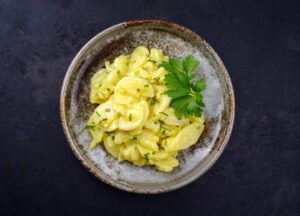
The Potato Salad is a common traditional German food found in almost every region. This salad became popular in the early 1900s and since then has been a common feature in every household. It is made with a mixture of potatoes, mayonnaise, and onions, which gives them a sort of tang. It is also served with fried eggs mixed into the salad. You will find this type of potato salad served at food festivals or events in Berlin, which makes it an ideal time to try it at least once.
- Wurst and Sauerkraut
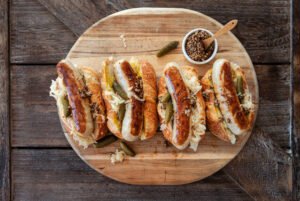
Traditional German food includes wurst and sauerkraut and both are equally enticing. Sauerkraut is a mixture of vegetables and is prepared to resemble the flavour of kraut. The main difference between the two is that sauerkraut is made with cabbage that has been cooked and salted, while wurst is made with meat and a variety of vegetables. These dishes can be found in restaurants serving traditional meals and are generally enjoyed as a side dish to your main course.
- Pretzel

Pretzel is known as ‘Brezel’ in Germany, although you may see them sold under either name. It is made with a long strip of dough which is folded into a knot and then boiled before being baked, this gives a chewy brown crust and a soft fluffy interior. You will find this knot-shaped bread across Berlin in bakeries, cafes, and street stands, and available in various flavours like cheese, seeds, chocolate, and many more. Although its origin is always contested, they have long been associated with Christian celebrations, with many viewing the knot shape as a symbol of the holy trinity. They make a fine pairing while drinking the finest German beers at a beer garden.
Traditional German Meat Dishes
- Rinderroulade (Beef Roll)
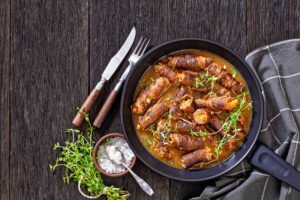
Rinderroulade is a typical German meat dish. It’s a common dish in the Saxony region that has different flavours, all packed in one single dish. It’s prepared by rolling thin slices of beef around bacon, onions, mustard and pickles, and is then roasted with red wine to create a deep rich flavour. Traditionally, it is served with mashed potatoes, potato dumplings or pickled red cabbage.
- Sauerbraten (Roast Beef Stew)
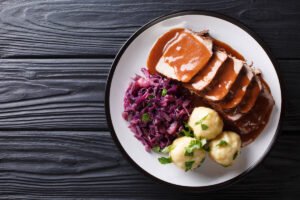
Sauerbraten is one of the national dishes in Germany and can be found in most restaurants across Berlin. This dish contains a slice of horse meat, beef, or venison. It is marinated in vinegar, spices, and wine mixture and left to rest for several days before it is roasted. It’s traditionally served along with boiled potatoes, potato dumplings and red cabbage.
- Königsberger Klopse (Meatballs)
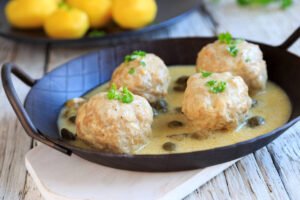
Königsberg is a common Berlin dish named after a German city. It consists of tender meatballs in creamy caper sauce. Traditionally, the meatballs are made with ground veal, eggs, onions, anchovies, pepper, and other spices. And it’s the sauce with capers along with lemon juice that gives this dish a perfect finish. The meatballs are served with beetroot or boiled potatoes. This meal is available in most German restaurants under the traditional name, and is more common in Berlin and Brandenburg.
- Schweinshaxe (German Pork Knuckle)

Schweinshaxe is a delicious meat dish and is more popular in the Bavarian region. It’s prepared by marinating the meat for several days. It’s then roasted at low temperatures for two to three hours or till the skin falls off from the bone. The meat becomes juicy and tender, and the skin brittle and crispy. It’s generally served with potatoes and different types of cabbages. This exotic meat dish is available across most restaurants in Berlin.
- Hasenpfeffer (Rabbit Stew)

In Germany – Hare is called ‘Hase,’ and pepper is ‘Pfeffer’.
Hasenpfeffer is a traditional stew made from marinated rabbit or hare. This delicious stew is prepared by braising rabbit meat with wine and onions and left to rest for hours. The marination is made with vinegar and wine, and is made thick with some rabbit blood. So, if you’re a stew lover you must try this dish during your food tours in Berlin.
Recommended Tour: Berlin Traditional Food Tour with Old Town Sightseeing
Traditional German Sausages
In Germany sausages are one of the most common foods having long traditional roots. In fact, Germany has up to 1,500 varieties of sausages. Here are the popular ones found across Berlin.
- Weisswurst

Commonly found in the Bavaria region – this traditional bacon sausage is made of pork back bacon and veal. And is seasoned with parsley, lemon, mace, onions, ginger, and cardamon to get a rich flavour. This meal can be eaten with pretzel, mustard, and a glass of beer. And is generally served as a mid-morning snack.
- Bratwurst

One of the most famous street foods in Berlin – Bratwurst is a fresh sausage made with veal and pork, and seasoned with coriander, nutmeg, ginger and caraway. This sausage is usually grilled over sizzling barbecue stands across the streets of Berlin. This sausage has a slightly crispy skin and is served with mustard and sauerkraut, mustard and ketchup, or in a bread roll. This delicious street food pairs well with German beer.
- Saumagen
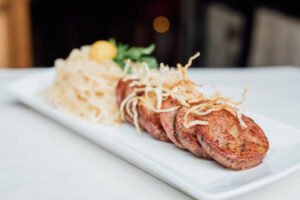
Saumagen translates to ‘sow’s stomach’, and is a famous German dish from the region of Palatinate. It was created in the 18th century by local farmers as a way to make use of leftover food. The preparation involves stuffing potatoes, pork, marjoram, carrots, onions, nutmeg, and white pepper in the stomachs of a pig casing. The sausage is then chopped and roasted in a frying pan or oven. This meal can be accompanied with mashed potatoes, sauerkraut, and a glass of dry white wine or traditional wheat beer.
Other Popular German Dishes
- Spargel (Asparagus)
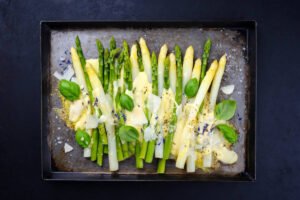
One of the most popular German staples is the white asparagus. It’s harvest time is around April and that’s when most restaurants in Germany add this vegetable to their menus. In Berlin restaurants, spaghetti is steamed and boiled, it’s then eaten with hollandaise sauce, olive oil or melted butter. It also comes stacked up with schnitzel or wrapped in bacon, asparagus soup, fried asparagus, pancakes, asparagus and herbs, asparagus with scrambled eggs or asparagus with potatoes.
- Käsespätzle

This dish is Germany’s answer to pasta, and these soft egg noodles are made from wheat flour and egg and are often topped with cheese and roasted onions. Traditionally, it is served as a side dish in meat stews or dipped into a soup. It’s a popular meal in beer gardens in summer and cosy Berlin pubs in winter.
- Döner Kebab
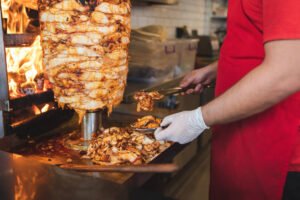
Technically speaking, this dish is of Turkish origin that made its way to Berlin and has evolved since its introduction in the 1970s. This dish is a kebab that is cooked on a vertical rotisserie with outer layers being cut off as they cook and are then served. In Berlin, this snack is served tucked within bread with some slaw and salad alongside the meat. It’s generally available in sandwich and wrap forms, and you can try them at any restaurant or from a kebab street vendor, across Berlin.
- Schnitzel
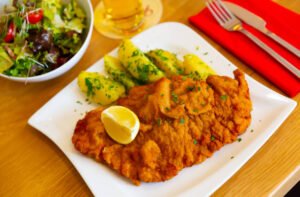
This is another iconic Berlin dish. In German ‘Schnitz’ means ‘to slice’ – schnitzels are thin slices of veal, pork, or chicken that are coated with flour, eggs, breadcrumbs and then fried in butter. There are also vegetarian options made with cheese or oysters. Although this dish originated in Vienna, you can still find some great versions of this dish in Berlin, such as the one at Sheers Schnitzel. It’s a typical German food served in bars, restaurants, and fast-food eateries.
- Senfeier
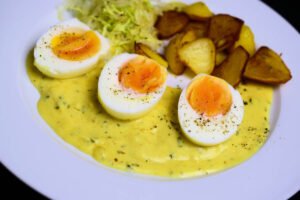
Senfeier literally translates to ‘German mustard eggs’ – this vegetarian German egg dish that features boiled eggs and served with mashed potatoes, and covered in a creamy mustard sauce. Usually enjoyed around Easter time, you’ll find this traditional German side mostly in breakfast and lunch restaurants across Berlin, and is a comfort food or light dinner rather than a full-on meal.
Traditional German Desserts
- Apfelstrudel (Apple pastry)

Travellers with a sweet tooth can’t imagine Berlin without its Apfelstrudel. Although it’s believed this dish originated in Arabia, it came a long way from Egypt to Austria and Germany. This pastry is made with thin layers of dough that are filled with apples and spices. It’s then baked and served with sweet icing, sugar glaze or powdered sugar. It’s usually served warm and accompanied by vanilla cream. It can be found across cafes in Berlin.
- Eierkuchen

Eierkuchen is an authentic German pancake that is typically made with bacon and onions. It’s a popular dish across Germany and is often eaten as a main course, as a side dish, or even as a dessert. It’s a simple delicacy that is found in most cafes and restaurants across Berlin and can be enjoyed by people of all ages.
- Black Forest Cake

Black Forest Cake is a dessert that is very popular with locals and tourists visiting Germany. It was first created in the Black Forest (Schwarzwald), a region in Germany. The cake is made with chocolate sponge cake layers and whipped cream. And is usually served with cherry sauce or kirschwasser. Although many variations of this cake can be found across the world, the authentic Black Forest Cake can be hard to get anywhere else outside of Germany. This dessert is generally served after a long traditional meal.
Bizarre German Dishes
- Himmel und Erde
Do you want to try a weird or erratic dish in Berlin? then Himmel und Erde (Earth and Heaven) should be top on your bucket list. In its appearance it can look messy or an unappealing dish, but it’s worth trying. This dish has been around since the 18th century and is more common in Rhineland, Westphalia and Lower Saxony regions. The dish is made with black pudding, mashed potatoes, fried onions and apple sauce. It’s a preferred meal in many breweries and beer halls and pairs well with a glass of beer.
German Christmas Foods
If you are visiting Berlin during the festive season of Christmas then here’s your chance to enjoy a few more delicious meals from the Germans. As most cultures mark traditions and festivals with food – the Christmas foods in Germany include some drinks, main meals, and desserts. Here are some of the traditional German dishes that are included in meals during this festive season:
- Semmelknödel – Bavarian Bread dumplings dipped in rich gravy from the braised roast.
- Crispy roasted goose prepared with onions, thyme and fruit.
- Lebkuchen – Gingerbread cookies were popular with medieval monks, dating back to the 13th century in Germany.
- Rotkohl – German braised red cabbage topped with juniper berries, green apple and tangy vinegar.
- Classic German stollen – almond-filled, moist, aromatic and flavourful stollen.
- German Krautstrudel – a delightful savoury cabbage roll with soft sauteed strands of cabbage, savoury crunch of caraway seeds, and the smoky flavour of bacon which is all wrapped in a delicate and flaky crust.
- German Lebkuchen Bars is a classic German variation of a gingerbread cookie.
Food Tours in Berlin with Rosotravel
Traditional German dishes have many variations and depending on which part of the country you are visiting; you may get more than one kind of German food available.
In Berlin most restaurants and cafes prepare German cuisines from all regions and are available to locals and tourists alike. However, as a tourist you may not know much about German food served in restaurants or street foods.
So, the best way to experience authentic German food is to book food tours in Berlin with Rosotravel that comes with a 5-star expert guide.
Many restaurants have their menus in German, so it’s easy to get confused on what to order or the quantity, especially if you have never tried German foods. Thus, our expert guide will guide you on this and even teach you one or two things about different German cuisines.
Also, you must know that a large part of eating German food is actually eating it raw. But you can try it in whatever form that you find most appealing. During the food tour you’ll get a chance to taste different varieties of traditional German dishes and drinks.
And if you want to learn about the various cooking techniques and ingredients used in German cuisines, our expert guide will answer all your food related queries.
Recommended Tour: Berlin Traditional Food Tour with Old Town Sightseeing
So, there you have it, this is only the tip of the iceberg when it comes to German cuisines.
You now understand why traditional German dishes are so rich, delicious, and loved by people from all over the world.
If you are a foodie and visiting Berlin you must spend time exploring street food markets, food festivals, alongside restaurants and fine dining. Good, hearty food can be found in every nook and corner of Berlin.
So, before your trip to Germany, make sure to keep this list of traditional dishes on hand, so that you can get a taste of them during your food tours in Berlin.


